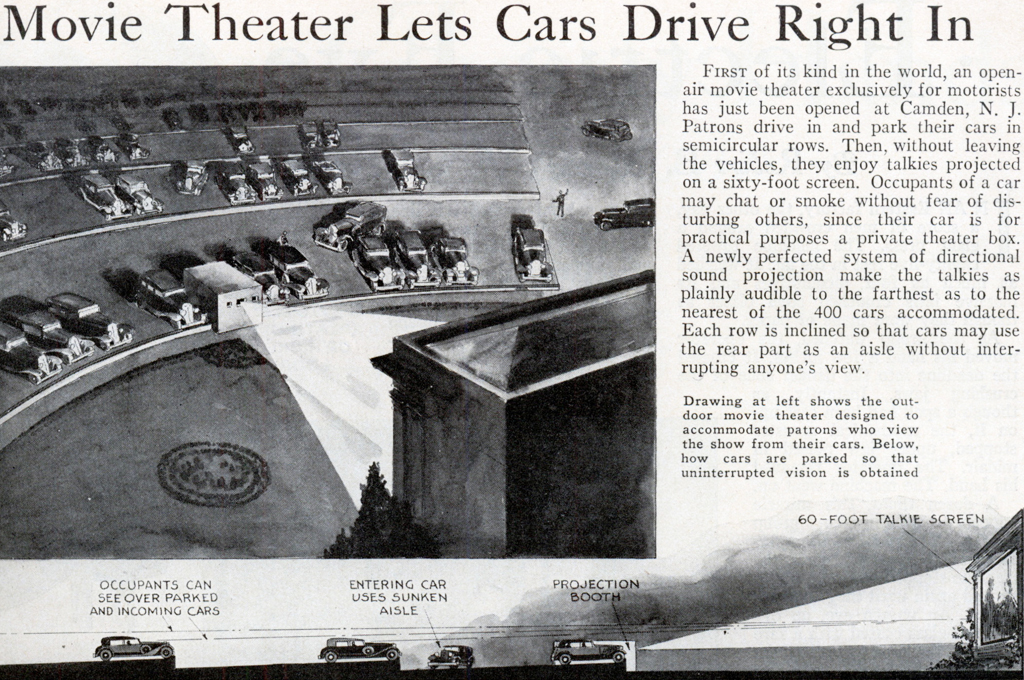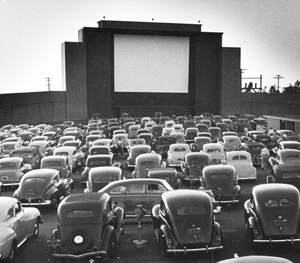 If you plan on heading to a drive-in movie theater this summer, as I did this past Saturday night for the first time in over 30 years, you will have high hopes for an enjoyable experience. To make sure reality lives up to the nirvana and zen you envision, it helps to remember a number of small realities about drive-in movie theaters – because accepting the inevitable pitfalls beforehand eases the pain. Then you and your guests can be as relaxed and comfortable as you would be in your own living room.
If you plan on heading to a drive-in movie theater this summer, as I did this past Saturday night for the first time in over 30 years, you will have high hopes for an enjoyable experience. To make sure reality lives up to the nirvana and zen you envision, it helps to remember a number of small realities about drive-in movie theaters – because accepting the inevitable pitfalls beforehand eases the pain. Then you and your guests can be as relaxed and comfortable as you would be in your own living room.
For example, the drive-in movie theater we went to did not feature the kind of flat, easy to negotiate parking lot portrayed in most movies and nostalgic photos. Ours was built into a hill, which makes complete sense for visibility because that allows each row of parking to be higher than the one in front of it. Cars with low roofs are directed toward front rows while sport utilities and vans are guided to the rear.
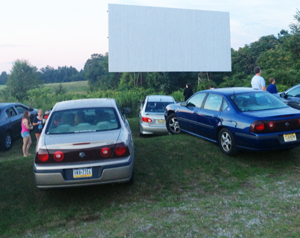 The modern reality is most drive-ins that do exist these days are built into sloping hills out of necessity. Towns often have height-regulation ordinances that somehow get applied to outdoor entertainment venues, so a screen placed at the bottom of a downhill slope is less likely to meet local resistance. And with land more expensive than ever, stadium rows of parking optimize all available space more efficiently. The downside to you is that you will be doing some driving up and over shallow hills, probably on an unpaved field of grass than can be quite muddy after even the slightest of rainy spring seasons. Not a big deal, but if you’re vain about your car’s freshly-scrubbed whitewalls and waxed paint… just know going into it that you’ll need to give the car you may have just washed another bath when you get home. Mud has a way of cursing a vehicle pretty well once it gets into tire treads.
The modern reality is most drive-ins that do exist these days are built into sloping hills out of necessity. Towns often have height-regulation ordinances that somehow get applied to outdoor entertainment venues, so a screen placed at the bottom of a downhill slope is less likely to meet local resistance. And with land more expensive than ever, stadium rows of parking optimize all available space more efficiently. The downside to you is that you will be doing some driving up and over shallow hills, probably on an unpaved field of grass than can be quite muddy after even the slightest of rainy spring seasons. Not a big deal, but if you’re vain about your car’s freshly-scrubbed whitewalls and waxed paint… just know going into it that you’ll need to give the car you may have just washed another bath when you get home. Mud has a way of cursing a vehicle pretty well once it gets into tire treads.
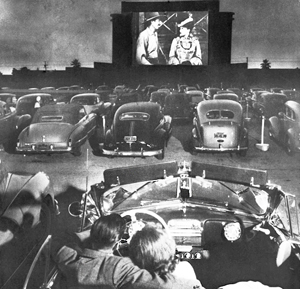 Bring a container of wet-wipes. A whole container, not just a few tucked in a plastic bag. Trust me on this. Whether you bring snacks or buy them on-site, you’ll have crumbs. While towels over the seats will protect you from crumbs going in between the seat jambs, they will simply redirect the crumbs onto the floor. You’ll also get mud from the field inside your car as well as on it. Even if you bring all your own snacks and don’t spill them, you’ll inevitably need to step out of the car to use the restroom. This requires mud-walking. Hasn’t rained all week, you say? Doesn’t matter, because try as you may to avoid the soggy spots, in the dark all odds favor you will feel at least one dreaded squish under your sneakers from holes in the ground still soggy from last week’s rain. So prepare to vacuum the car and foam the carpets when you get home if a clean interior is important to you. And be smarter than I was by not dropping your baggie with (only) three or four wet wipes in the mud, like i did.
Bring a container of wet-wipes. A whole container, not just a few tucked in a plastic bag. Trust me on this. Whether you bring snacks or buy them on-site, you’ll have crumbs. While towels over the seats will protect you from crumbs going in between the seat jambs, they will simply redirect the crumbs onto the floor. You’ll also get mud from the field inside your car as well as on it. Even if you bring all your own snacks and don’t spill them, you’ll inevitably need to step out of the car to use the restroom. This requires mud-walking. Hasn’t rained all week, you say? Doesn’t matter, because try as you may to avoid the soggy spots, in the dark all odds favor you will feel at least one dreaded squish under your sneakers from holes in the ground still soggy from last week’s rain. So prepare to vacuum the car and foam the carpets when you get home if a clean interior is important to you. And be smarter than I was by not dropping your baggie with (only) three or four wet wipes in the mud, like i did.
Considering the length of the trip to reach the remote areas most modern drive-ins are located plus the length of the movie (up to three hours for double features), you’ll be getting out of your vehicle to use the bathroom more than once. And if the bathrooms are port-o-johns, you will definitely want the wet wipes.
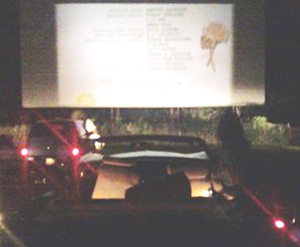 Park with enough room to open your doors without the risk and rudeness of dinging a neighbors body panels (and vice-verce), but try also to park close enough to allow for more cars to be slotted in side-by-side. Otherwise, you may encounter a stressed movie theater employee who will undoubtedly ask you to move over a few feet after your guests have situated their drinks and chips in easy-to-spill positions. And spill they will, because you’ll be maneuvering fore and aft over uneven, rutted ground. Disaster strikes easily at these moments, especially when latecomers are straggling in along the narrow lanes between rows. Because these narrow lanes are often on the edge of an upward slope leading to the next plateau of stadium parking, a great deal of left-to-right tilt is involved. Navigating anything larger than a compact through these areas is extremely risky… especially if the aforementioned mud in the field has turned mild inclines into slippery slopes.
Park with enough room to open your doors without the risk and rudeness of dinging a neighbors body panels (and vice-verce), but try also to park close enough to allow for more cars to be slotted in side-by-side. Otherwise, you may encounter a stressed movie theater employee who will undoubtedly ask you to move over a few feet after your guests have situated their drinks and chips in easy-to-spill positions. And spill they will, because you’ll be maneuvering fore and aft over uneven, rutted ground. Disaster strikes easily at these moments, especially when latecomers are straggling in along the narrow lanes between rows. Because these narrow lanes are often on the edge of an upward slope leading to the next plateau of stadium parking, a great deal of left-to-right tilt is involved. Navigating anything larger than a compact through these areas is extremely risky… especially if the aforementioned mud in the field has turned mild inclines into slippery slopes.
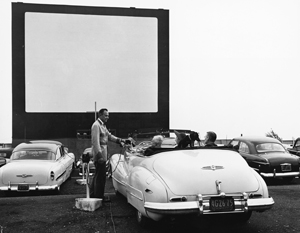 Drive-in movie theaters no longer supply microphones that hang on car windows. Now you simply tune in to a selected radio frequency and listen to the sound track in stereo comfort. Much, much better than it used to be! But if you plan to take in a double-feature, make sure your vehicle’s battery is up to three hours of radio-on, engine-off use or you’ll be dealing with the inconvenience of asking strangers for a jump-start at the end of the night…when all they want to do is go home (maybe to clean up their spills and muddy side flanks). If you’re like me, that battery in your classic car that gets driven only on nice days may be weaker than you think. If you plan to take it to the drive-in, put it on a trickle charger the night before you plan to go. My own battery was having trouble holding a charge, so I checked my records to see how old it was and was shocked to realize it was five years old, not two or three as I’d thought. Time flies when you’re not looking. Before my drive-in trip, I bought a new battery to avoid grief and embarrassment in front of my guests.
Drive-in movie theaters no longer supply microphones that hang on car windows. Now you simply tune in to a selected radio frequency and listen to the sound track in stereo comfort. Much, much better than it used to be! But if you plan to take in a double-feature, make sure your vehicle’s battery is up to three hours of radio-on, engine-off use or you’ll be dealing with the inconvenience of asking strangers for a jump-start at the end of the night…when all they want to do is go home (maybe to clean up their spills and muddy side flanks). If you’re like me, that battery in your classic car that gets driven only on nice days may be weaker than you think. If you plan to take it to the drive-in, put it on a trickle charger the night before you plan to go. My own battery was having trouble holding a charge, so I checked my records to see how old it was and was shocked to realize it was five years old, not two or three as I’d thought. Time flies when you’re not looking. Before my drive-in trip, I bought a new battery to avoid grief and embarrassment in front of my guests.
And, lastly, put enough gas in the car…or maybe not. Happy driving-in…
-Sean (originally published 7-6-2009, Sean Connor, The Examiner)

